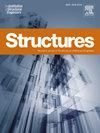一种新型自适应注浆演化套筒抗拉性能的试验与数值研究
IF 4.3
2区 工程技术
Q1 ENGINEERING, CIVIL
引用次数: 0
摘要
在预制混凝土结构中,垂直钢筋通常采用灌浆套筒连接。然而,目前的灌浆套筒在安装过程中容易出现不可避免且难以检测的灌浆缺陷,给结构的安全带来了潜在的风险。为了解决这一问题,本文提出了一种新型的自适应注浆演化套筒(SAGES)连接方式。与传统灌浆套筒采用标准灌浆工艺不同,sage采用“预灌浆-钢筋”工艺,提高了灌浆质量的可控性,提高了与施工误差的相容性。钢筋端部结构的设计及其内部锥形截面的几何优化显著提高了这些性能。对所提出的SAGES进行了单轴拉伸试验,以评估其在静态拉伸条件下的力学性能。此外,利用ABAQUS软件进行了一系列分析,探讨了影响SAGES锚固机理和承载性能的因素。结果表明,SAGES接头通过其独特的注浆工艺,保证了注浆的完全性。此外,混合锚固机构有效地防止了连接构件的滑动破坏,充分利用了连接钢筋的材料性能。本文章由计算机程序翻译,如有差异,请以英文原文为准。
Experimental and numerical investigation into the tensile performance of a novel self-adaptive grouting evolved sleeve
In prefabricated concrete structures, vertical rebars are typically connected using grouting sleeves. However, current grouting sleeves are prone to unavoidable and hard-to-detect grouting defects during installation, which pose potential risks to the safety of these structures. To address this challenge, this paper proposes a novel self-adaptive grouting evolved sleeve (SAGES) connection. Unlike traditional grouting sleeves, which rely on a standard grouting process, the SAGES employs a "pregrout-rebar" process, which improves the controllability of grouting quality and enhances its compatibility with construction errors. The design of the steel bar end configuration and the geometric optimization of its internal conical section significantly enhance these properties. Uniaxial tensile tests were conducted on the proposed SAGES to assess its mechanical properties under static tensile conditions. Additionally, ABAQUS software was used to perform a series of analyses to explore the factors influencing the anchorage mechanism and load-bearing performance of SAGES. The findings demonstrate that the SAGES connection, through its unique grouting process, ensures complete grouting. Moreover, the mixed anchorage mechanism effectively prevents sliding failure of the connection components, allowing for the full utilization of the material performance of the connecting reinforcement.
求助全文
通过发布文献求助,成功后即可免费获取论文全文。
去求助
来源期刊

Structures
Engineering-Architecture
CiteScore
5.70
自引率
17.10%
发文量
1187
期刊介绍:
Structures aims to publish internationally-leading research across the full breadth of structural engineering. Papers for Structures are particularly welcome in which high-quality research will benefit from wide readership of academics and practitioners such that not only high citation rates but also tangible industrial-related pathways to impact are achieved.
 求助内容:
求助内容: 应助结果提醒方式:
应助结果提醒方式:


